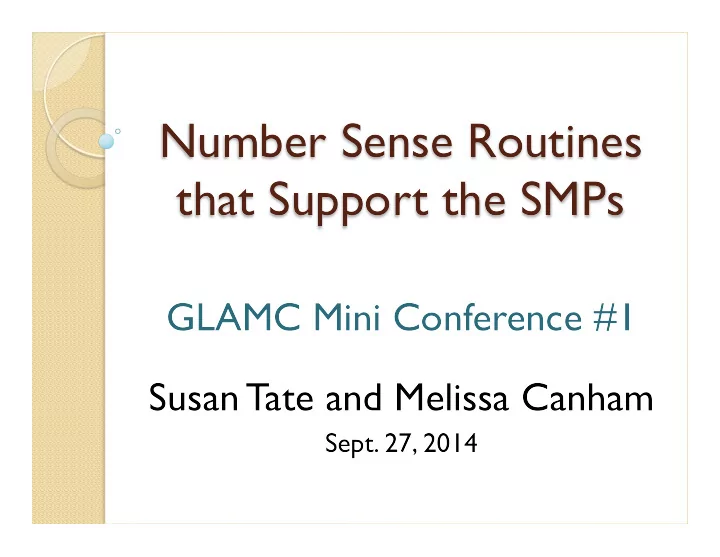

Number Sense Routines that Support the SMPs GLAMC Mini Conference #1 Susan Tate and Melissa Canham Sept. 27, 2014
Number Sense “Number sense is an awareness and understanding about what numbers are, their relationships, their magnitude, the relative effect of operating on numbers, including the use of mental mathematics and estimation.” Number Sense and Operation Sense Fennell and Landis (1994)
Focus Areas in Support of Rich Instruction and Grade Expectations of Fluency and Conceptual Understanding Addition and subtraction K-2 concepts, skills, and problem solving, and place value Multiplication and division of whole numbers 3-5 and fractions concepts, skills, and problem solving Ratios and proportional reasoning; early expressions and 6 equations Ratios and proportional reasoning; arithmetic of rational 7 numbers 8 Linear algebra and linear functions
What does Cognitively Guided Instruction (CGI) Look Like? Problem solving is the focus of instruction; teachers pose a variety of problems Many problem-solving strategies are used to solve problems. Children decide how they should solve each problem. Children communicate to their teachers and peers how they solve the problems. Teachers understand children’s problem-solving strategies and use that knowledge to plan instruction.
What is a Routine? 5 – 15 minutes during the opening of math time Short lesson alongside (but not necessarily directly related to) the ongoing math curriculum Provide students with meaningful ongoing practice with: ◦ Computation ◦ Number Sense ◦ Place Value ◦ Standards for Mathematical Practice ◦ Listening to others’ strategies ◦ Properties of Operations
Four Goals for K-2 Routines Developing Number Sense Developing fluency with small numbers Subitizing Making Tens Number Talks - Sherry Parrish
The Standards for Mathematical Practice Make sense of problems and persevere in solving them. 1. Reason abstractly and quantitatively. 2. Construct viable arguments and critique the reasoning of 3. others. Model with mathematics. 4. Use appropriate tools strategically. 5. Attend to precision 6. Look for and make use of structure 7. Look for and express regularity in repeated reasoning. 8.
Number of the Day Tell me about 53.
Number of the Day Open ended exploration around a given number ◦ Can you make the given number in more than one way? ◦ How many different numbers can you use to create your number sentence? ◦ Can you use more than one operation to create your number sentence? ◦ What other kinds of numbers can you use in your equations?
Ten Wand Combinations of Ten Part-part-whole Commutative Property of Addition Using the 10 structure
Number Talks Number Strings True/False Number Sentence Quick Images
Quick Images
True/False Number sentences
Hundreds Chart
Hundreds Chart
Hundred Chart
Hundred Chart
Computational fluency refers to having efficient and accurate methods for computing. Students exhibit computational fluency when they demonstrate flexibility in the computational methods they choose, understand and can explain these methods, and produce accurate answers efficiently . The computational methods that a student uses should be based on mathematical ideas that the student understands well, including the structure of the base-ten number system, properties of addition and subtraction and multiplication and division, and number relationships. Principles and Standards for School Mathematics p. 152
The Standards for Mathematical Practice Make sense of problems and persevere in solving them. 1. Reason abstractly and quantitatively. 2. Construct viable arguments and critique the reasoning of 3. others. Model with mathematics. 4. Use appropriate tools strategically. 5. Attend to precision 6. Look for and make use of structure 7. Look for and express regularity in repeated reasoning. 8.
CGI Website www.dusd.net/cgi
Thank You! state@dusd.net mcanham@dusd.net www.dusd.net/cgi
References Conklin, Melissa. It Makes Sense! Using the Hundreds Chart to Build Number Sense . Math Solutions, 2012 Parrish, Sherry. Number Talks . Math Solutions, 2010 Shumway, Jessica . Number Sense Routines . Stenhouse Publishers, 2011.
Recommend
More recommend